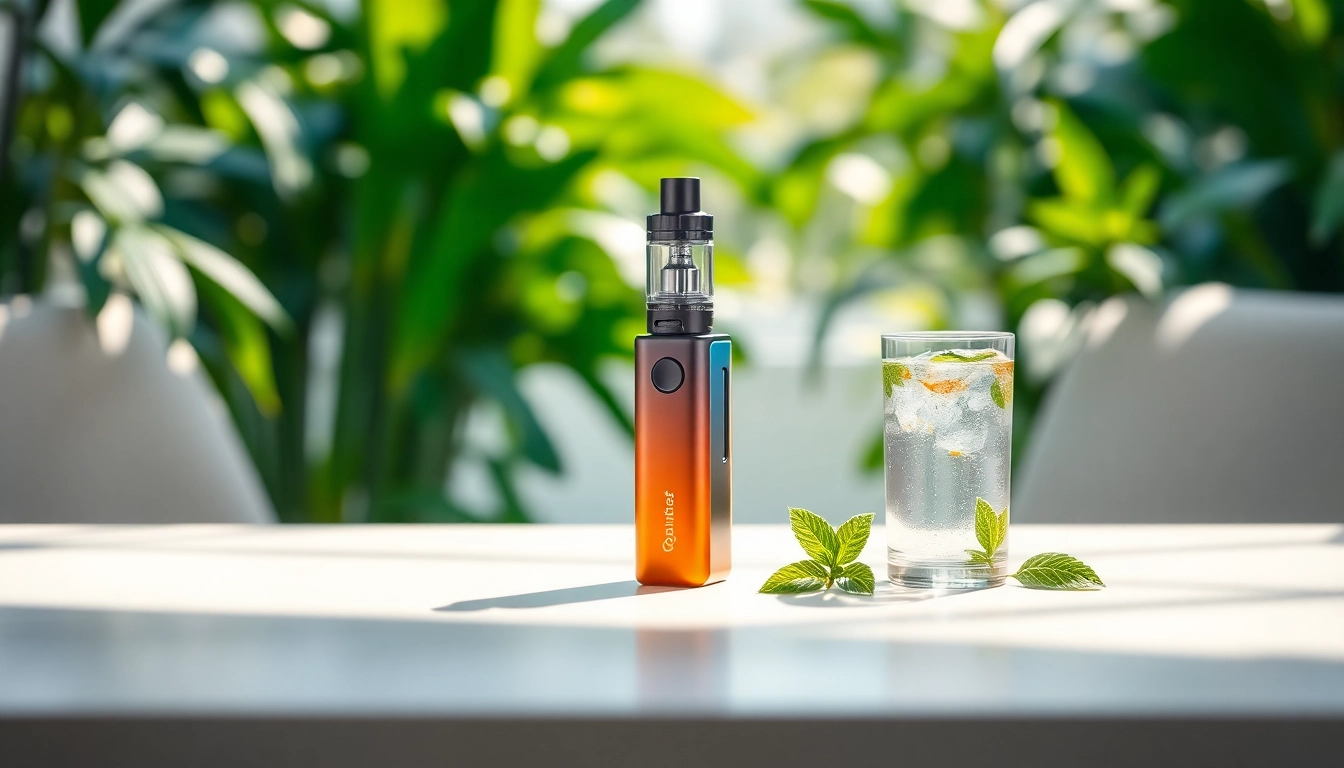The Rise of Healthy Vapes in Today’s Market
In recent years, the vape industry has witnessed a significant transition toward healthy vapes. With growing health awareness and increasing regulatory scrutiny on traditional smoking products, consumers are becoming more discerning about what they inhale. The notion of “healthy vapes” encapsulates devices and e-liquids that prioritize user well-being, claiming to offer alternatives to the harmful effects of traditional cigarettes. As the market expands, understanding the landscape of these healthier alternatives becomes paramount.
Defining Healthy Vapes and Their Benefits
Healthy vapes typically refer to e-cigarettes or vape pens that use less harmful substances when compared to conventional tobacco products. The core benefits of healthy vapes include:
- Reduced Harmful Chemicals: Most healthy vapes do not contain the multitude of toxins found in traditional cigarettes, such as tar and carcinogens.
- Customizable Ingredients: Users can often choose e-liquids that are free from nicotine or contain lower nicotine levels, appealing to those who wish to reduce their dependency.
- Flavor Variety: Healthy vapes often feature natural flavorings, allowing for a more enjoyable smoking experience without the bitter taste of tobacco.
- Less Odor: The vapor produced by healthier options tends to dissipate quickly, leaving minimal scent, unlike traditional smoking.
Consumer Trends Shaping the Vaping Industry
Market analytics indicate a noticeable shift in consumer preferences, driven by health considerations. A surge in awareness about the dangers of smoking has led many users to migrate toward less detrimental options. This shift is partly fueled by social media campaigns highlighting the dangers of traditional smoking and the advantages of vaping. Additionally, younger audiences are increasingly prioritizing products that resonate with their health-conscious lifestyles, resulting in a proliferation of brands promoting natural ingredients and cleaner options.
Comparative Analysis with Traditional Vaping Products
When comparing healthy vapes to traditional vaping products, several key differences emerge:
- Ingredient Transparency: Healthy vapes often focus on transparency regarding the ingredients used in their products, providing consumers with data about sourcing and processing.
- Health Claims and Credentials: Many healthy vape brands strive to obtain certifications from health authorities, bolstering consumer trust.
- Market Positioning: Traditional vaping products may prioritize flavor and cloud production over health, while healthy vapes appeal to consumers interested in wellness and lifestyle compatibility.
Understanding the Ingredients in Healthy Vapes
Healthy vapes are distinguished by their ingredient composition, which necessitates a closer examination of what goes into these products.
Natural vs. Synthetic Flavorings
Flavorings are a pivotal aspect of any vaping experience. Healthy vapes tend to utilize natural flavorings derived from food-grade ingredients, which are often perceived as safer alternatives to synthetic flavoring agents. Natural flavorings can provide a more authentic taste profile and are generally considered more acceptable to health-conscious consumers. However, it’s essential to note that not all natural ingredients are automatically safe, and rigorous testing should ensure their quality.
Evaluating the Safety of Common Ingredients
It’s crucial to differentiate between ingredients that may be harmful versus those that are considered stable in vaping contexts. Common ingredients found in healthy vapes include:
- Vegetable Glycerin (VG): Generally recognized as safe for consumption, VG is a thick, sweet liquid that produces substantial vapor.
- Propylene Glycol (PG): Often used for its flavor-carrying properties, PG is also regarded as safe, though some users may prefer to avoid it due to potential sensitivities.
- Nicotine: While many healthy vapes are nicotine-free, it’s essential for consumers who choose nicotine options to understand its effects and source.
Assessing THC and CBD in Vaping Products
The popularity of cannabinoids like THC (tetrahydrocannabinol) and CBD (cannabidiol) has been instrumental in creating health-focused vaping alternatives. These substances are derived from cannabis and have gained notoriety for their therapeutic effects. Healthy vapes that feature THC or CBD often tout benefits such as reduced anxiety, pain relief, and improved sleep quality. As research into the effects and applications of these compounds continues to unfold, they are rapidly becoming a go-to option for many seeking natural remedies.
Choosing the Right Healthy Vape Device
With various devices available on the market, selecting the correct healthy vape can seem daunting. Understanding device types and their features is essential for a satisfying experience.
Types of Devices Available for Consumers
Healthy vaping devices can generally be categorized into several types:
- Open System Vapes: These allow users to refill e-liquids, providing flexibility in flavors and nicotine ratios.
- Closed Pod Systems: These are pre-filled pods that can be swapped out once empty, delivering convenience for those new to vaping.
- Disposable Vapes: Ideal for beginners, these are designed for single-use and come pre-filled, simplifying the vaping process.
Factors to Consider When Selecting a Device
Choosing the right device involves considering several factors:
- Ease of Use: New users may prefer straightforward devices with minimal setup, while experienced users might seek advanced features.
- Customization: The ability to adjust settings such as wattage and airflow may be important for seasoned vapers seeking a tailored experience.
- Portability: For those on the go, compact and lightweight devices are preferable.
Maintaining Your Vape for Optimal Performance
Regular maintenance is key to ensuring the longevity and performance of your vape device. Here are tips to keep your device in top shape:
- Cleaning: Regularly clean the tank and mouthpiece to prevent build-up and ensure flavor quality.
- Battery Care: Ensure the battery is charged adequately and follow manufacturer guidelines to avoid overcharging.
- Storage: Keep your vape in a cool, dry place to protect its components from excess heat or moisture.
Healthy Vaping Practices for New Users
Transitioning to healthy vaping from traditional smoking can be challenging but rewarding. New users should approach this transition with informed practices to maximize benefits.
How to Transition from Traditional Smoking to Vaping
For those looking to make the switch, consider the following steps:
- Start Slowly: Begin by replacing a few cigarettes daily with vaping, gradually increasing as you feel comfortable.
- Select Compatible Flavors: Opt for flavors that replicate or complement the taste of traditional tobacco to ease the transition.
- Track Your Consumption: Monitoring usage can help in gradually diminishing nicotine dependence.
Setting Realistic Goals for Your Vaping Journey
It’s essential to establish achievable milestones on your path to healthier choices. Consider setting goals around:
- Reducing nicotine levels over time.
- Experimenting with different flavors to find enjoyable alternatives.
- Engaging in social situations without cardiovascular side effects.
Finding Supportive Communities and Resources
Support can significantly impact the vaping experience. Online forums and local groups often provide the following:
- Shared Experiences: Learning from others who have transitioned can provide motivation and tips for success.
- Product Reviews: Community members frequently share insights on the best devices and e-liquids to use.
- Health Information: Accessing accurate and helpful resources can help navigate the complexities of healthy vaping.
Regulations and the Future of Healthy Vapes
As with any evolving industry, the regulatory landscape surrounding vaping products is turbulent. Understanding current laws and anticipating future shifts are imperative for consumers and businesses alike.
Current Laws Governing Vaping Products
Regulations regarding vaping products vary greatly by region. Key considerations include:
- Age Restrictions: Most jurisdictions enforce age limits on the purchase and use of vaping products.
- Labeling Requirements: Transparency in ingredient listings is mandated in many regions to protect consumers.
- Advertising Regulations: Stricter guidelines on how vaping products can be marketed aim to curb youth access and use.
What to Expect in the Next Few Years
As consumer preferences continue to sway towards healthier options, manufacturers are likely to innovate further. Expect advancements in:
- Ingredient Quality: Increased demand for organic and verified ingredients may reshape formulations.
- Device Technology: Improvements in battery life, safety features, and ease of use will likely emerge to meet consumer needs.
- Research and Development: Growing investment in scientific studies may establish new data supporting the health benefits of certain vaping protocols.
The Role of Scientific Research in Vaping Innovations
Ongoing scientific research plays a vital role in enhancing our understanding of what constitutes a healthy vape. Emerging studies aim to evaluate:
- Long-term health impacts of vaping versus smoking.
- The efficacy of cannabis-infused vapes for medical purposes.
- New extraction methods for developing safer e-liquids.
As the vaping landscape continues to develop, scientific evidence will undoubtedly guide both consumer choices and regulatory measures, leading to better health and safety standards across the board.



